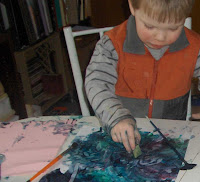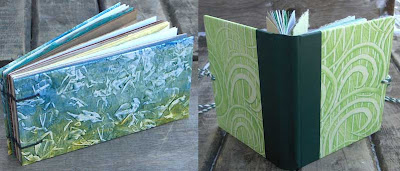 So, rubber stamps weren't the only thing we did in our printmaking course. Oh no, not at all. In fact, we covered so many things, I could barely take notes fast enough. The scope of the course included: lino prints, reduction printing, dark field monotype printing, trace-style monotypes, pressure prints, painted monotypes, a bit of colophon printing, and of course, screen printing. Then we covered some fun folding book structures at the end, which is a great way to visualize the process in the realm of book arts. This first picture shows Matt demonstrating the silk screen printing process.
So, rubber stamps weren't the only thing we did in our printmaking course. Oh no, not at all. In fact, we covered so many things, I could barely take notes fast enough. The scope of the course included: lino prints, reduction printing, dark field monotype printing, trace-style monotypes, pressure prints, painted monotypes, a bit of colophon printing, and of course, screen printing. Then we covered some fun folding book structures at the end, which is a great way to visualize the process in the realm of book arts. This first picture shows Matt demonstrating the silk screen printing process. The greatest bonus with silk screen printing is the ability to create many many many prints - once the screen is prepared, making the actual prints is slick and quick. As a class, we created a screen for printing some two-sided origami paper. I think there were a million prints made...or maybe about 50...something like that. Everyone was able to take a few sheets anyway. Matt showed us how to use a dark room and light table for exposing the screens, and then also showed us how to do it just by exposing the screen in direct sunlight for a couple minutes. So it can be done without too much special gear...that's nice to know. Although I don't think I'll take up screen printing.
The greatest bonus with silk screen printing is the ability to create many many many prints - once the screen is prepared, making the actual prints is slick and quick. As a class, we created a screen for printing some two-sided origami paper. I think there were a million prints made...or maybe about 50...something like that. Everyone was able to take a few sheets anyway. Matt showed us how to use a dark room and light table for exposing the screens, and then also showed us how to do it just by exposing the screen in direct sunlight for a couple minutes. So it can be done without too much special gear...that's nice to know. Although I don't think I'll take up screen printing.I tried reduction printing, and stencil printing, and a couple monotype prints. But I found that I was most drawn to creating printing blocks with linoleum. I decided to create a few related images, resulting in these "Reminders of my Grandfather."



During the course, I created about half a dozen of these lino cuts. The last photo shows some of the linoleum blocks with the prints. We had access to a couple printing presses, but we also printed by hand without a press. The beauty of this being, that I can print them again...! Seems like a really basic concept, but it actually took a couple days before I understood this fully. I've already been to the art store to buy some ink and a brayer and more linoleum... I'm looking forward to using some of these new things in my books.






























